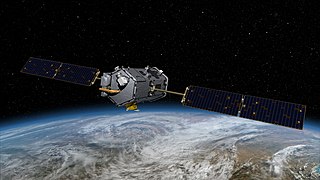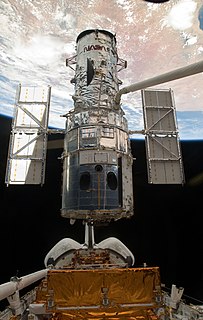
Ariane 5 is a European heavy-lift launch vehicle that is part of the Ariane rocket family, an expendable launch system designed by the French government space agency Centre national d'études spatiales (CNES). It is used to deliver payloads into geostationary transfer orbit (GTO) or low Earth orbit (LEO).
Orbital Sciences Corporation was an American company specializing in the design, manufacture and launch of small- and medium- class space and rocket systems for commercial, military and other government customers. In 2014 Orbital merged with Alliant Techsystems to create a new company called Orbital ATK, Inc., which in turn was purchased by Northrop Grumman in 2018. Orbital Sciences Corporation today is a subsidiary of Northrop Grumman and is known as Northrop Grumman Innovation Systems.

The Meteor spacecraft are weather observation satellites launched by the USSR and Russia. The Meteor satellite series was developed during the 1960s. The Meteor satellites were designed to monitor atmospheric and sea-surface temperatures, humidity, radiation, sea ice conditions, snow-cover, and clouds.

The Korea Aerospace Research Institute (KARI) established in 1989, is the aeronautics and space agency of South Korea. Its main laboratories are located in Daejeon, in the Daedeok Science Town. KARI's vision is to continue building upon indigenous launch capabilities, strengthen national safety and public service, industrialize satellite information and applications technology, explore the moon, and develop environmentally-friendly and highly-efficient cutting-edge aircraft and core aerospace technology. Current projects include the KSLV-2 launcher. Past projects include the 1999 Arirang-1 satellite. The agency was founded in 1989. Prior to South Korea's entry into the IAE in 1992, it focused primarily on aerospace technology.

This is a timeline of first orbital launches by country. While a number of countries have built satellites, as of 2018, eleven countries have had the capability to send objects into orbit using their own launch vehicles. Russia and Ukraine inherited the space launchers and satellites capability from the Soviet Union, following its dissolution in 1991. Russia launches its rockets from its own and foreign (Kazakh) spaceports. Ukraine launched only from foreign launch facilities until 2015, after which political differences with Russia effectively halted Ukraine's ability to produce orbital rockets. France became a space power independently, launching a payload into orbit from Algeria, before joining space launcher facilities in the multi-national Ariane project. The United Kingdom became a space power independently following a single payload insertion into orbit from Australia, before discontinuing official participation in space launch capability, including the Ariane project, in the 1970s.

A payload fairing is a nose cone used to protect a spacecraft against the impact of dynamic pressure and aerodynamic heating during launch through an atmosphere. More recently, an additional function on some flights has been to maintain the cleanroom environment for precision instruments. Once outside the atmosphere the fairing is jettisoned, exposing the payload to the space environment.

The Orbiting Carbon Observatory (OCO) is a NASA satellite mission intended to provide global space-based observations of atmospheric carbon dioxide. The original spacecraft was lost in a launch failure on 24 February 2009, when the payload fairing of the Taurus rocket which was carrying it failed to separate during ascent. The added mass of the fairing prevented the satellite from reaching orbit. It subsequently re-entered the atmosphere and crashed into the Indian Ocean near Antarctica. The replacement satellite, Orbiting Carbon Observatory 2, was launched 2 July 2014 aboard a Delta II rocket. The Orbiting Carbon Observatory 3, a stand-alone payload built from the spare OCO-2 flight instrument, will be installed on the International Space Station's Kibō Exposed Facility in April 2019.
Arirang-2, also known as KOMPSAT-2, is a South Korean multipurpose reconnaissance satellite. It was launched from Plesetsk Cosmodrome, Russia at 4:05 PM KST on 28 July 2006. It began to transmit signals at 11 PM the same day. Like the earlier Arirang-1 satellite, it takes its name from the popular Korean folk song Arirang. Its launch was the culmination of a project begun in 1999.

Several significant events in spaceflight occurred in 2009, including Iran conducting its first indigenous orbital launch, the first Swiss satellite being launched and New Zealand launching its first sounding rocket. The H-IIB and Naro-1 rockets conducted maiden flights, whilst the Tsyklon-3, Falcon 1 and Ariane 5GS were retired from service. The permanent crew of the International Space Station increased from three to six in May, and in the last few months of the year, Japan's first resupply mission to the outpost, HTV-1, was conducted successfully.

The year 2010 in spaceflight saw a number of notable events in worldwide spaceflight activities. These included the first test flight of the SpaceX Dragon commercial resupply spacecraft, which is intended to resupply the International Space Station (ISS), and the maiden flights of the Falcon 9 and Minotaur IV rockets. In June 2010, South Korea conducted a second Naro-1 launch, after the failure of the rocket's maiden flight in 2009; however, the second attempt also failed. The Kosmos-3M was retired from service, making its final flight in April. The Molniya-M was also retired from service, making its final flight in September.
Orbcomm is a family of low Earth orbit communications satellites, operated by the American satellite communications company Orbcomm. As of July 2014, 51 such satellites have orbited Earth, with 50 still continuing to do so.

KSLV-II, also known as Nuri (누리), is South Korea's second carrier rocket and the successor to KSLV-1. (Naro) KSLV-II is under development by KARI / Korea Aerospace Research Institute, and is planned to have its first flight in 2021. All three stages are planned to use indigenously developed rocket engines. The South Korean government is setting SpaceX as a 'role model', striving to develop relatively cheap and reliable rockets competitive enough for the commercial launch market. Currently the goal is to launch a 1,500 kg payload into a 600–800 km low Earth orbit (LEO) and 2,600 kg into a 300 km LEO.
This list is a comparison of orbital launcher families. To see the long complete list of launch systems, see Comparison of orbital launch systems.

STSAT-2C, or Science and Technology Satellite 2C, or Naro Science Satellite(ko:나로과학위성) is a South Korean satellite which was launched in 2013. It is operated by the Korea Aerospace Research Institute, and is intended to demonstrate technology for future spacecraft. The satellite has a mass of 100 kilograms (220 lb), and is expected to operate for less than a year.
Science and technology in South Korea has advanced throughout the decades.

A small-lift launch vehicle is a rocket orbital launch vehicle that is capable of lifting up to 2,000 kg (4,400 lb) of payload into low Earth orbit (LEO). The next larger category consists of medium-lift launch vehicles.

Omega, stylized as "OmegA", is a launch vehicle in development by Northrop Grumman as an NSSL replacement program intended for national security and commercial satellites.



















